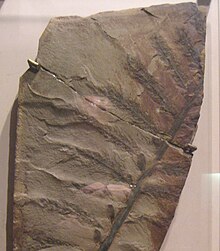Archaeopteris
|
Archaeopteris Temporal range: Late Devonian to Early Carboniferous |
|
|---|---|
 |
|
| Archaeopteris hibernica | |
| Scientific classification | |
| Kingdom: | Plantae |
| Division: | †Progymnospermophyta |
| Order: | Archaeopteridales |
| Family: | Archaeopteridaceae |
| Genus: |
Archaeopteris Dawson (1871) |
| Species | |
Archaeopteris is an extinct genus of tree-like plants with fern-like leaves. A useful index fossil, this tree is found in strata dating from the Upper Devonian to Lower Carboniferous (383 to 323 million years ago), and has a global distribution. The name derives from the ancient Greek (archaīos) meaning "ancient", and (ptéris), meaning "fern".
Until the 2007 discovery of Wattieza, many scientists considered Archaeopteris to be the earliest known tree. Bearing buds, reinforced branch joints, and branched trunks similar to today's timber, it is more reminiscent of modern seed-bearing trees than other spore bearing taxa; It combines characteristics of woody trees and herbaceous ferns, and belongs to a group of extinct plants sometimes called the progymnosperms, plants with gymnosperm-like wood but that produce spores rather than seeds.
The trees of this genus typically grew to 10 m (33 ft) in height with leafy foliage reminiscent of some conifers. The large fronds were thickly set with fan-shaped leaflets on stems that inclined sharply upward. The trunks of some species exceeded 1.5 metres (4.9 ft) in diameter. The veining branches diverged dichotomously. There was also intermediate feathering at each frond node or axes.
Leafy shoots occurred in opposite arrangement in a single plane. The leaflets, or pinnules, overlapped one another and were subcircular to wedge-shaped. On fertile branches, some of the leaves were replaced by spore capsules.
Aside from its woody trunk, Archaeopteris possessed other modern adaptations to light interception and perhaps to seasonality as well. The large umbrella of fronds seems to have been quite optimized for light interception at the canopy level. In some species, the pinnules were shaped and oriented to avoid shading one another. There is evidence that whole fronds were shed together as single units, perhaps seasonally like modern deciduous foliage or like trees in the cypress family Cupressaceae.
...
Wikipedia
